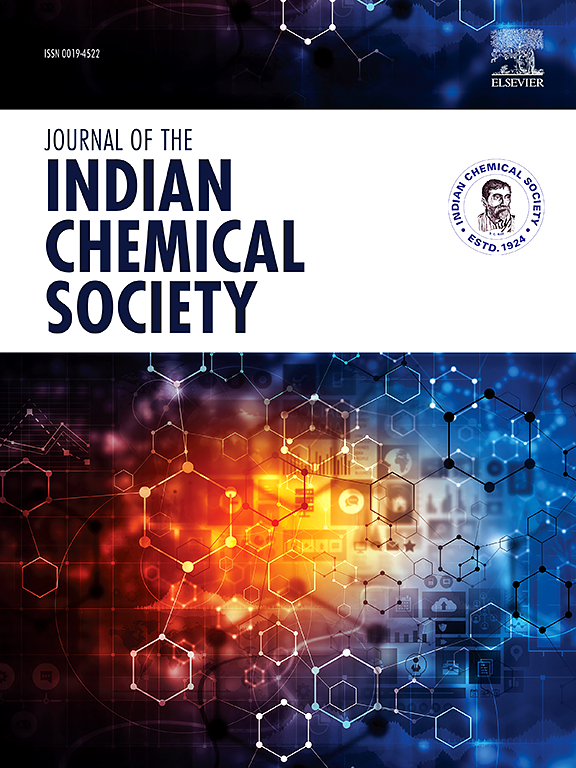Bio-engineered Ce/Ba doped and Ce–Ba Co-doped CuO and Co3O4 nanoparticles for improved photocatalytic and biological assessments
IF 3.2
4区 化学
Q2 CHEMISTRY, MULTIDISCIPLINARY
引用次数: 0
Abstract
CuO and Co3O4 NPs are renowned nanomaterials due to their exceptional features that contribute to the antibacterial and photocatalysis domains. In this study, Ce/Ba doped and Ce–Ba co-doped CuO and Co3O4 nanoparticles (NPs) were engineered via a green method to enhance antibacterial, antioxidant efficiency and degrade congo red and rhodamine B by photocatalysis under UV radiations. The physicochemical properties of the NPs were identified by using several analytical techniques. The crystallite sizes of monoclinic Ce/Ba doped and Ce–Ba co-doped CuO were 12.38 and 9.92 nm, respectively, as confirmed by XRD. Similarly, the cubic samples of Ce/Ba doped and Ce–Ba co-doped Co3O4 NPs exhibited crystallite sizes of 12.94 and 6.08 nm. The FTIR analysis recorded the possible involvement of functional groups of biomolecules in the synthesized samples. The distribution of elements and their morphology was further indicated by SEM-EDX and TEM. The band gap values viz. 1.09 and 1.15 eV were determined from the UV–vis absorption analysis for Ce–Ba co-doped CuO and Co3O4 NPs, respectively. In particular, the Ce–Ba co-doped CuO degraded 93.20 and 91.56 % of congo red and rhodamine B within 50 and 60 min, respectively as compared to Ba-doped CuO showing 80–86 % degradation for both dyes. The scavenging activity shown by the same sample was also 88.67 %. The Ce–Ba co-doped CuO NPs exhibited the highest bacterial killing efficacy against gram- (+) and (−) bacteria. The exceptional performance of the samples was ascribed to the coupling of single-doped CuO and Co3O4 NPs with the Ce ions for upgrading the properties of the material for a sustainable ecosystem.

生物工程Ce/Ba掺杂和Ce - Ba共掺杂CuO和Co3O4纳米颗粒用于改进光催化和生物评价
CuO和Co3O4 NPs是著名的纳米材料,因为它们具有独特的特性,有助于抗菌和光催化领域。在这项研究中,通过绿色方法设计了Ce/Ba掺杂和Ce - Ba共掺杂的CuO和Co3O4纳米粒子(NPs),以提高抗菌和抗氧化效率,并在紫外线辐射下通过光催化降解刚果红和罗丹明B。采用多种分析技术对NPs的理化性质进行了鉴定。XRD证实单斜Ce/Ba掺杂和Ce - Ba共掺杂CuO的晶粒尺寸分别为12.38 nm和9.92 nm。同样,Ce/Ba掺杂和Ce - Ba共掺杂的Co3O4 NPs的立方样品的晶粒尺寸分别为12.94和6.08 nm。FTIR分析记录了合成样品中可能涉及的生物分子官能团。SEM-EDX和TEM进一步表征了元素的分布和形貌。通过对Ce-Ba共掺杂的CuO和Co3O4 NPs的紫外-可见吸收分析,测得其带隙值分别为1.09和1.15 eV。与ba掺杂CuO相比,Ce-Ba共掺杂CuO在50 min和60 min内对刚果红和罗丹明B的降解率分别为93.20%和91.56%,而ba掺杂CuO对两种染料的降解率分别为80 - 86%。同一样品的清除率为88.67%。Ce-Ba共掺杂的CuO NPs对革兰氏-(+)和(−)细菌的杀伤效果最高。样品的优异性能归因于单掺杂CuO和Co3O4 NPs与Ce离子的耦合,以提高材料的性能,从而实现可持续的生态系统。
本文章由计算机程序翻译,如有差异,请以英文原文为准。
求助全文
约1分钟内获得全文
求助全文
来源期刊
CiteScore
3.50
自引率
7.70%
发文量
492
审稿时长
3-8 weeks
期刊介绍:
The Journal of the Indian Chemical Society publishes original, fundamental, theorical, experimental research work of highest quality in all areas of chemistry, biochemistry, medicinal chemistry, electrochemistry, agrochemistry, chemical engineering and technology, food chemistry, environmental chemistry, etc.

 求助内容:
求助内容: 应助结果提醒方式:
应助结果提醒方式:


